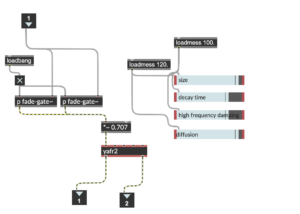The previous post documented what can be seen as the beginning sound block of the sonification piece, which replicates the same sonified granular system across the eight channels of a 7.1 surround system, each crossfading to a second on triggered for interactive audio replacement. By this stage, the sounding result is a texture with spectral qualities that feel similar to the high-fidelity soundscape capture but granularly rearranged, providing a first sense of acceptance and normality, followed by disorientation and pattern unrecognition when listening actively—a result of the interest of its own, and presented in the final result as such. However, further resynthesis and processing were desired, a linear variable that could morph between this first scenario and one other that felt otherworldly, hollow, and with an “upside down” feeling. This linear variable was achieved by designing a parallel crossfaded signal flow, with heavy processing between a delay line loop and a parallel reverb. This “morphing linear variable” was envisioned with the intent of interfacing with user-controlled gestures that will be explored in further blog posts.
A delay system can be achieved in Max/MSP by simply using a ~tapin and a ~tapout together, where the very common “Delay Time” parameter is defined through this second one. These two objects, on their own, however, do not sound “delayed” in the sense of the effect. Since these two objects delay an incoming signal once, no repetition of this instance will be heard. Therefore, and as commonly known across the common conception of a delay effect, a signal loop is built into this system with a signal multiplier factor between the value of 0 and 1, which as a variable is famously known as the “Feedback Amount”. With the feedback loop set, the signal gets re-delayed to silence like an expected “traditional” delay effect, and from this point, things get more interesting. By allocating other types of processing inside this loop, the effects will also get repeated accordingly. When these processing block’s parameters behave dynamically, things get really interesting. This way, we no longer solely loop an audio signal but also the effect of the processing blocks over time. In this project, three processing blocks are set, with there respective parameters:
-
- A low-pass filter — Cut-off frequency;
- A pitch shifter — Pitch;
- And a tremolo/ring-modulator — Modulating frequency and Ramp Time;
Having this set-up settled, this dynamic behaviour that shapes sound in such interesting ways is provided by the method of sonification by assigning the fluctuations of the variable by the flowing data set and its factors (previously described in the past blog posts). After some experimentation and careful tuning over scale a smoothening, the sonification reflects over the following connections:
-
- Delay Time –> R coordinate;
- Feedback Amount –> Intensity;
- Cutoff Frequency –> G coordinate;
- Pitch –> B coordinate;
- Tremolo/Ring -Modulation modulator frequency –> X coordinate
- Ramp time Tremolo/Ring -Modulation –> Y coordinate.
Another processing aspect of this parallel path in a crossfaded linear variable is a reverb unit inspired by the Cycle’74 example. With a fixed set of parameters, this reverb unit presents a very large, reflective-sounding place with a hollow and industrial feel. (Figure 1)

As the last blog post mentioned, this system is set individually across each of the eight channels of the 7.1 surround sound system.
If you’re reading this in order, please proceed to the next post: ‘Sonfication #5 – 7.1 Panning and Surround Sound Layout’.

